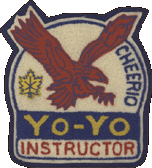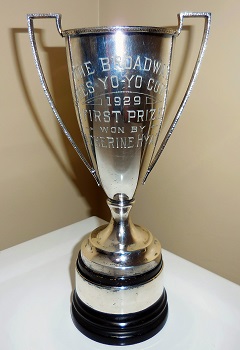                |
 |
 Sponsors and Curators Sponsors and Curators
The Museum of Yo-Yo History is a labor of love, and we would not be able to stay up-to-date with exhibits without the support of our sponsors and curators. Big thanks go to One Drop Design and Duncan for supplying us with their latest models, YoYoExpert for their help and support, and to Cody Orr, TotalArtist and YoYoBrothers™ for allowing us to use their collections!
If you're a manufacturer, or just a big collector and you want to help support the Museum drop me at line at chimera@yoyomuseum.com
|
 |
 |
 |
|
|
 |
| Flores 1929 First (1st) Prize trophy |
| Exhibit #2342 |
 |
 |
| Type | Event |
| Condition | Mint |
| Date | 1929 |
| Owner | Owner Owner |
| Compare |  |
|
|
At the Museum of Yo-Yo History, we share pictures and information about yo-yos and yo-yo memorabilia, their history across generations and from around the world. Occasionally, we introduce rare—and sometimes vintage—items that are truly unique and one-of-a-kind. Indeed, some of these items have a definitive place in yo-yo history. They also have the added bonus of telling a story. The Flores Yo-Yo Contest Trophy and accompanying two newspaper articles in this exhibit are consummate pieces of yo-yo history you will not see or read about anywhere else.
Our story begins in 1929 at The Broadway Department Store in Los Angeles, California. A 13 year old girl named Catherine Hyatt from Long Beach, along with "hundreds of Yo-Yo enthusiasts from Southern California" entered their first yo-yo contest (see the "1929 newspaper story" in this exhibit). Not only was the yo-yo contest a new phenomenon among youth, it was held by Pedro Flores. Mr. Flores is the young man credited with starting the new toy's popularity in the United States just one year earlier. (It is also worth noting that the time period of this contest was literally months before Donald F. Duncan--whose last name is now synonymous with yo-yo--purchased Flores' interest to begin a new chapter in yo-yo history.) Of the 20 winners in the contest, only Catherine from the girls group, and a young boy named Toshio Nakamura from the boys group, went on to win first place trophies.
Yo-Yo contests in 1929 bore little resemblance to the yo-yo contests that most of us can recall from our youth. In fact, many basic and advanced yo-yo tricks known by their traditional names today (such as Rock the Baby and Around the World) were not even invented until the next decade because of one simple change made to the string by Flores (answer is near the end of this exhibit!). Instead, the Flores Yo-Yo spinning contest was made competitive by observing which contestants could make their yo-yo spin, up and down only, on the string the longest. In the end, it would usually come down to a contest of who had the backbone and stamina to outlast all other spinners. Other very rudimentary yo-yo tricks, such as the Forward Pass, were also incorporated into the contests.
The trophy that Catherine was awarded in 1929 is currently (2021) the earliest known yo-yo contest trophy in existence. The engraving on the trophy reads, from top to bottom:
THE BROADWAY
FLORES YO-YO CONTEST
1929
FIRST PRIZE
WON BY
CATHERINE HYATT
The silver portions of the trophy are silver-electroplated Britannia metal. The cup is attached to a base of painted black metal. On the underside of the base is a ring/washer engraved with MERIDENB.CO 1106 indicating the Meriden Britannia Company founded in 1852 in Meriden, Connecticut. The silver-electroplating is in good condition considering the trophy is more than 86 years old. There are a few small, thinning portions of silver, possibly due to polishing or handling. However, there are no scratches.
The trophy specifications are as follows:
• Height - 292mm (11.5 inches)
• Widest width - 152mm (6 inches)
• Diameter at the top of the cup - 89mm (3.5 inches)
• Diameter at the base - 102mm (4 inches)
• Approximate weight is 1 to 1.5 pounds
Later in life, Catherine Hyatt married and raised three daughters: Barbara, Roberta, and Jo Ann. Catherine's husband, Norman, worked in the oil field business in Bakersfield, California. In 1948, Catherine again made news, this time in The Bakersfield Californian newspaper (see the 1948 newspaper story in this exhibit). The story reported Catherine as a former yo-yo champion 20 years earlier and who was now teaching her three daughters how to "operate" a yo-yo in preparation for a yo-yo contest in Bakersfield. Catherine is shown holding in her left hand a "modern" wooden yo-yo with white painted stripes, while in the other hand holding the string. Her youngest daughter (Jo Ann) on the right side of the picture is holding her mother's 1929 Flores award trophy. The year 1948 is approximately the time that Duncan began to ramp up yo-yo production following the end of World War II, three years earlier. It is quite possible that Catherine is holding a Duncan yo-yo in the picture.
In 1949, when oil was discovered in Alberta, the family moved from Bakersfield to Canada. When Norman retired in the 70's they moved back to California. Catherine and Norman passed away in 2006 and 2008, respectively, in Washington state.
Today (2016), a generation later, the Brookes' three daughters share in the ownership of the trophy and the two accompanying newspaper articles.
While the original yo-yo used by Catherine in 1929 has long since disappeared, it is possible that she used a Flores similar to this Flores Yo-Yo from 1928/29. Early Flores yo-yos were made of wood and had very narrow string gaps. The string was tied to the axle causing the yo-yo to only rotate, up and down, on the string like the yo-yos that contestants used in the 1929 contest. Flores would soon afterward change all that by looping the string around the axle to make the yo-yo "sleep" on the end of the string; a new technique for yo-yo play. And thus began the invention of hundreds of new string tricks and the yo-yo's popularity that is still spinning around the world today.
-----
On behalf of the Museum of Yo-Yo History, we extend our gratitude to the three sisters for preserving and sharing the yo-yo legacy left by their mother, all for the rest of the world to enjoy and learn more about.
(This exhibit was written and prepared by Rick Brough, museum curator.)
|  |
| |
|
Other Examples
|
|
|
|
|
|  |
|
|
 |
|
|
 |
 |
|

